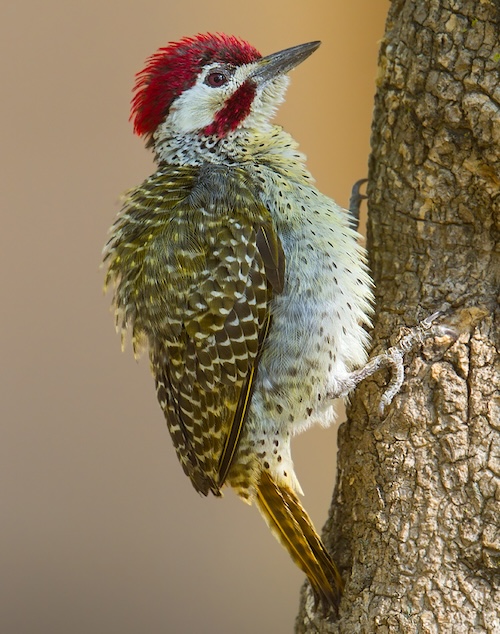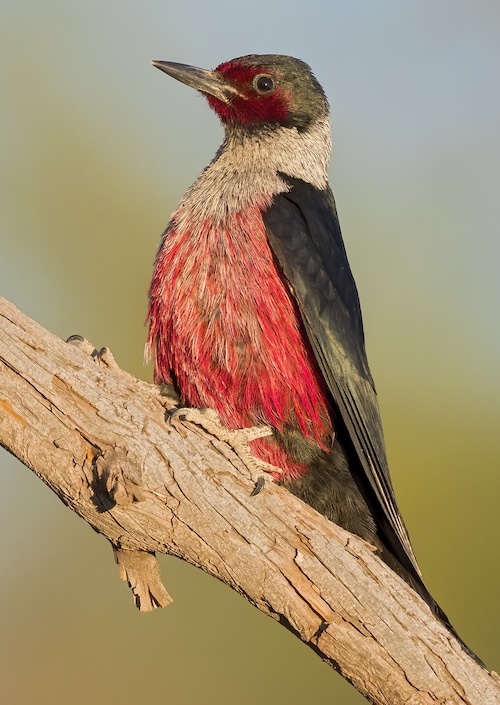Picidae – Woodpeckers
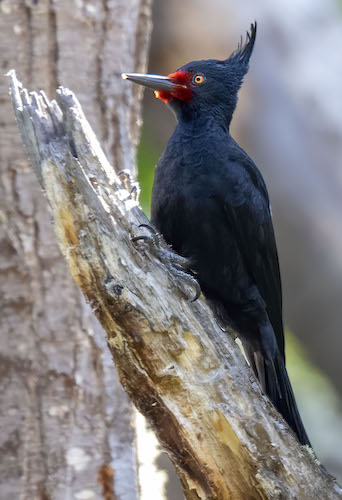
The Picidae (Woodpeckers) are a family of near passerine birds of the order Piciformes, which also includes Capitonidae (New-World Barbets), Megalaimidae (Asian Barbets), Lybiidae (African Barbets), Ramphastidae (Toucans) and Indicatoridae.
They have a stout, relatively long bill and robust body designed for chiselling into wood. Woodpecker feet are adapted to climbing trees, with two toes pointing forward and two back (one of which can also be bent sideways to improve grip) and a stiff tail that provides extra support. Most woodpeckers have a skull that is reinforced at the bill base, a tongue that wraps clear around the rear of the skull into one of the eye sockets or nostrils, as well as the stiff-pointed tail, and zygodactyl toes.
Despite their distinctive habit of climbing up trees, not all feed there. Distributed around the world they range in size from the tiny piculets (only 8cm long) to the massive Imperial Woodpecker (55cm), both from South America.
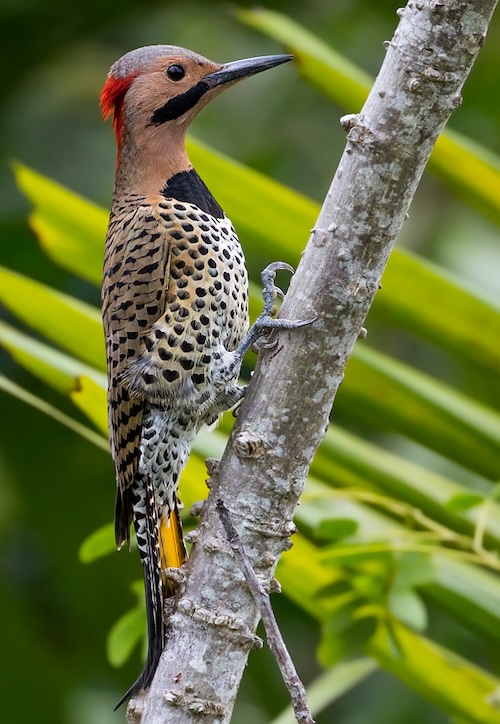 |
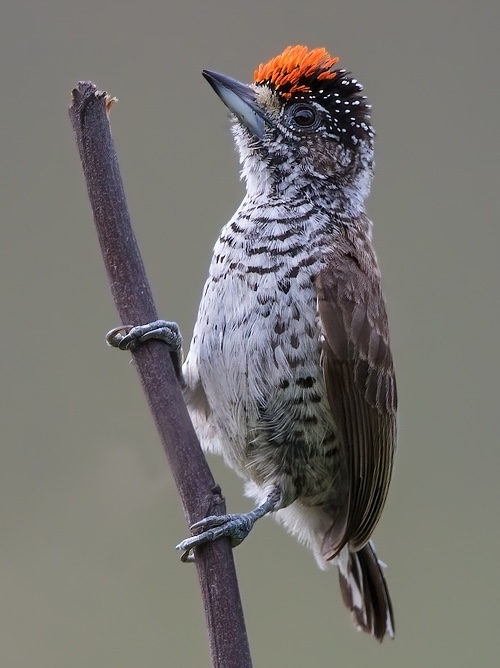 |
| Northern Flicker Colaptes auratus | White-bellied Piculet Picumnus spilogaster |
| All photos courtesy of ©Dubi Shapiro (unless otherwise attributed) | |
The family has diversified into every suitable habitat on Earth except for Madagascar and Australasia (east of Wallace’s line). In fact, ground-living woodpeckers occur even in treeless areas of the Southern Hemisphere.
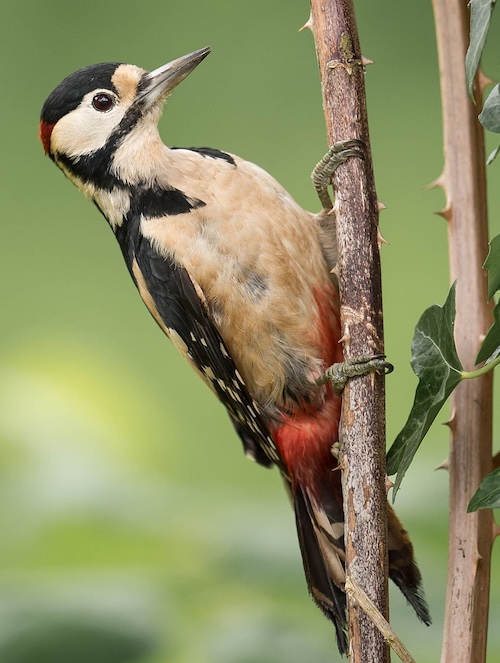 |
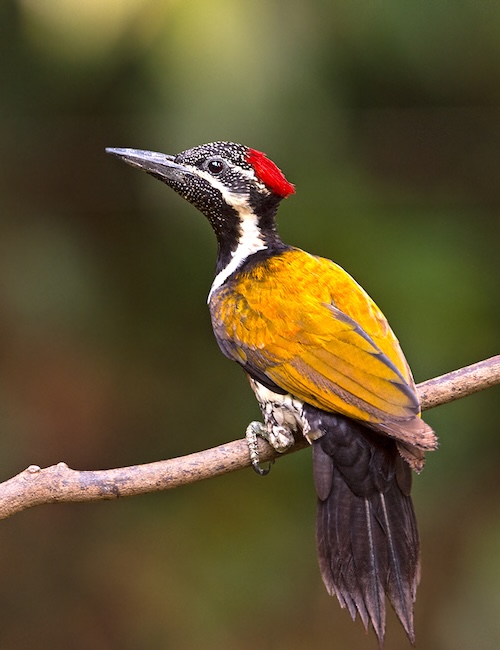 |
| Great Spotted Woodpecker Dendrocopos major | Black-rumped Flameback Dinopium benghalense |
| ©Jason Thompson CC BY 2.0 via Wikimedia Commons | ©Koshy Koshy BY 2.0 via Wikimedia Commons |
Unusual woodpeckers include the piculets, tiny nuthatch-like denizens of tropical woods, and the Old-World wrynecks, which writhe and stretch and hiss like a snake when threatened. Surprisingly, woodpeckers seldom reuse their nest cavities, and many species of cavity-adopting birds depend on the surplus holes that these birds produce.
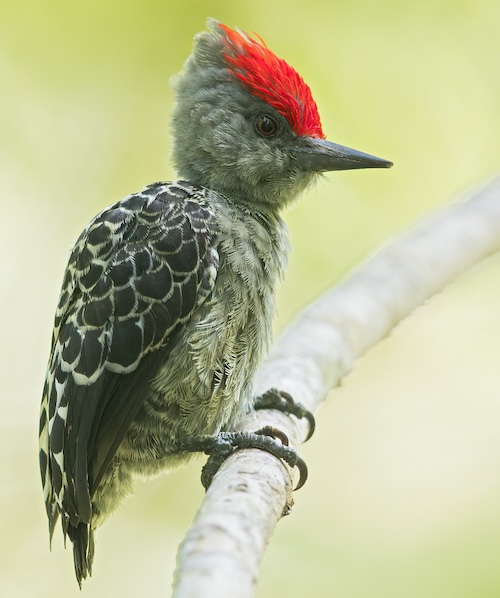 |
 |
| Grey-and-buff Woodpecker Hemicircus concretus | Pale-crested Woodpecker Celeus lugubris |
Gerard Gorman (author of a handbook on European woodpeckers) writes:
Woodpeckers are highly specialised and hence fascinating birds. Besides the true woodpeckers which are familiar and easily recognisable as such by almost all, including non-birders, the Picidae family also includes Wrynecks, Piculets, Flickers and Sapsuckers. The majority of woodpeckers are specialists in climbing tree trunks and in excavating their own nest-holes in trunks and branches.
 |
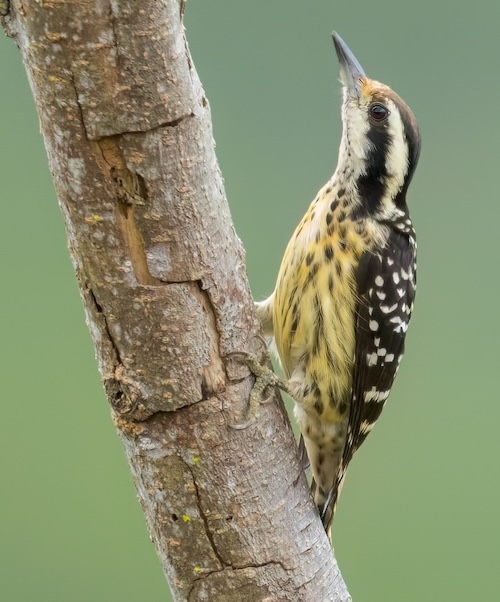 |
| Acorn Woodpecker Melanerpes formicivorus | Philippine Pygmy Woodpecker Yungipicus maculatus |
They have evolved certain anatomical adaptations such as strong feet with mobile toes, claws for clinging to smooth surfaces, stiff tail feathers to help them steady themselves on tree trunks and other vertical surfaces, strong chisel shaped bills and skulls with attached shock-absorbers and also very long tongues for probing into crevices and insect nests to search out larvae. The fact that woodpeckers are excavators of holes means that many species have become important as the suppliers of nest-holes for other birds, mammals and even insects. In Europe, for example, Black Woodpecker holes are occupied by Stock Doves and Pygmy Owls. In the deserts of Arizona, Elf Owls rely to a great extent on holes made by woodpeckers in cactus stands.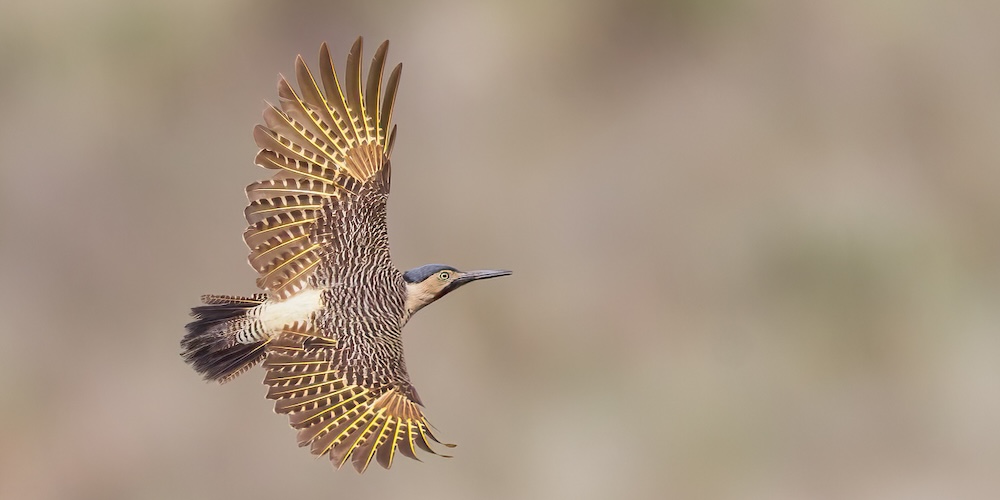
Andean Flicker Colaptes rupicola
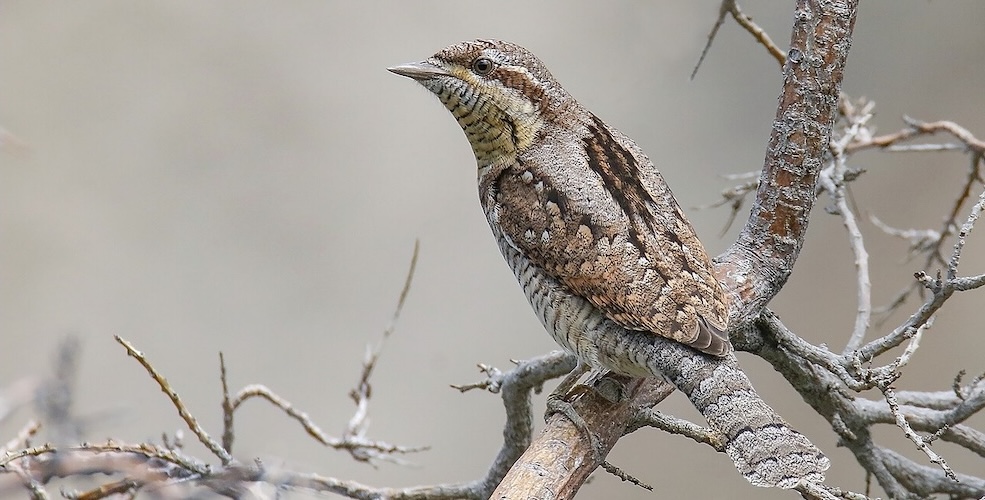
Eurasian Wryneck Jynx torquilla – ©Imran Shah CC BY-SA 2.0 via Wikimedia Commons
Another interesting feature of woodpecker behaviour is that many species also drum rather than sing. Several species also make use of anvils, workshops or a smithy. These terms refer to a place, usually a crevice or notch in a branch, tree-stump or even a wall, where birds wedge items of food such as nuts or pinecones and then hack them open to get at the contents.
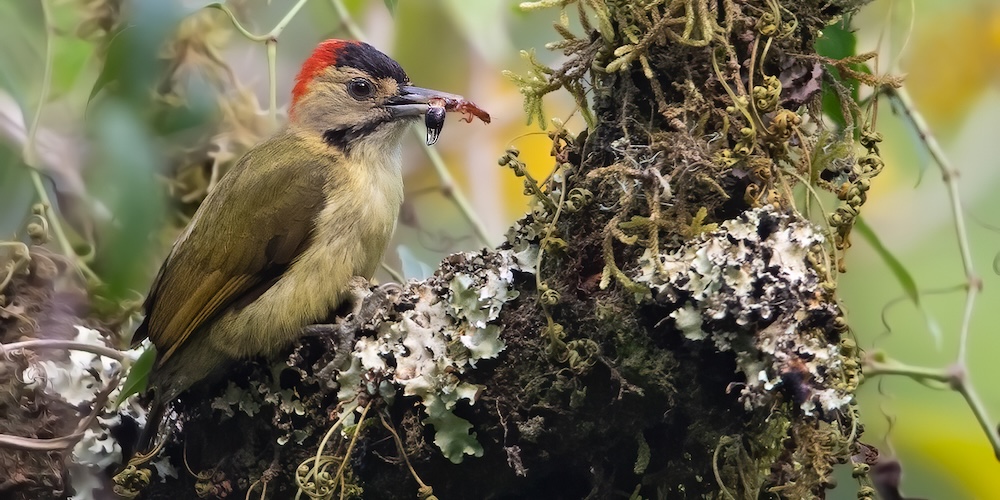
Elliot’s Woodpecker Dendropicos elliotii
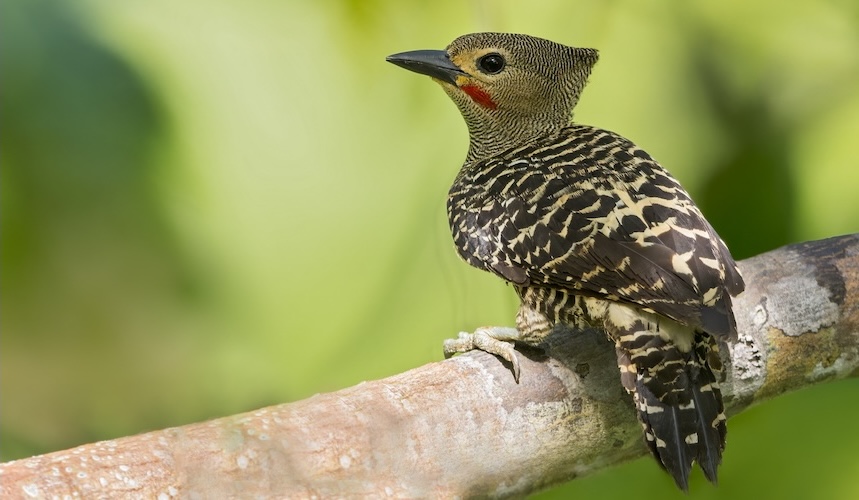
Buff-rumped Woodpecker Meiglyptes grammithorax
And if all these fascinating behavioural traits were not enough, many woodpeckers are also strikingly colourful and beautiful birds. The Greater Flameback and Black-headed Woodpecker of Southeast Asia are just two examples. And can you think of a bird with a better name than Yellow-bellied Sapsucker? Have you ever witnessed the fly-catching flight of Lewis`s Woodpecker? Watched a gregarious band of comical-looking Acorn Woodpeckers in action?
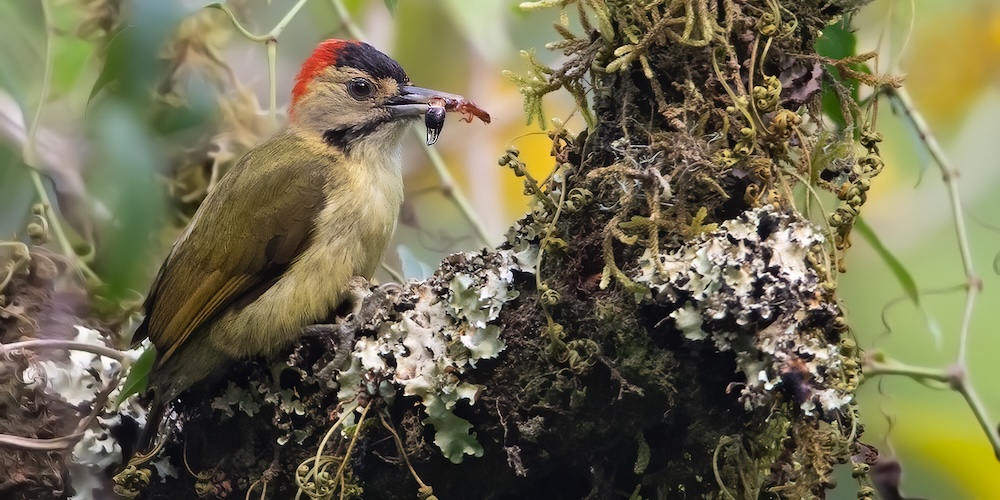
Checkered Woodpecker Veniliornis mixtus
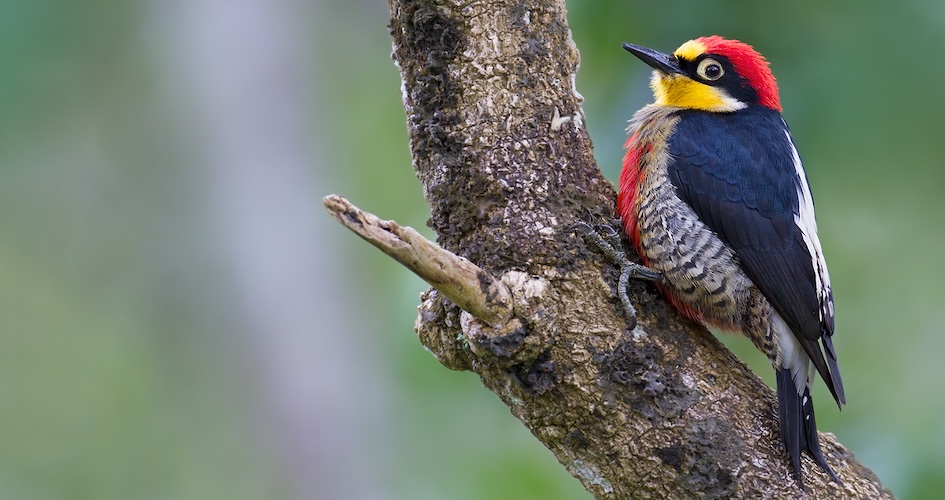
Yellow-fronted Woodpecker Melanerpes flavifrons
Yet, all things considered, it is probably the ability of woodpeckers to bore their own nest-holes in trees (and other plants) and their drumming (though not all woodpeckers drum) that really sets them apart. Of course, ornithologists and birders are fond of making cases for the uniqueness of their favourite bird families, but for me the features mentioned above and the morphology and behaviour of these birds combine to make woodpeckers one of the most enigmatic of bird families.
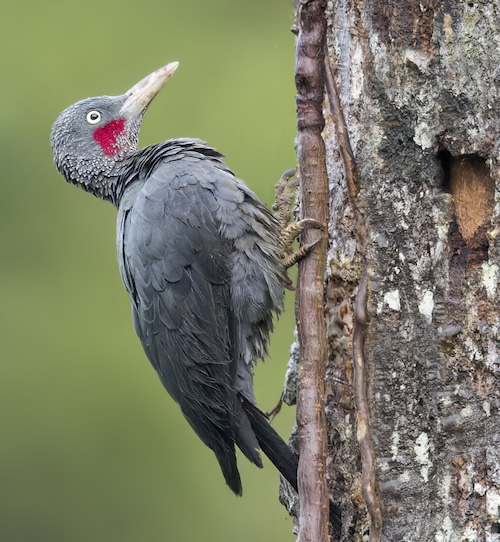 |
|
|
Southern Sooty Woodpecker Mulleripicus fuliginosus |
Checker-throated Woodpecker Chrysophlegma mentale |
Woodpeckers can be regarded as successful birds with the well over 200 species being fairly well distributed around the globe though, perhaps not surprisingly, they do not inhabit the treeless regions of the Arctic and Antarctic. However, their absence from some heavily wooded regions such as Australia and Madagascar is perhaps a surprise.
|
|
|
|
Bennett’s Woodpecker Campethera bennettii |
Lewis’s Woodpecker Melanerpes lewis |
Then again, some species have adapted to living in sparsely wooded grasslands such as the Nubian Woodpecker on the savanna of East Africa and the Campo Flicker in South America, and in barren stony areas as does the terrestrial Ground Woodpecker in South Africa, and as in the case of Gila Woodpecker even in deserts where there are more cacti than trees. The Neotropics are home to some of the most impressive species including the mighty Magellanic Woodpecker. Though most likely extinct two huge and enigmatic species, Imperial and Ivory-billed, are/were birds to rival any, anywhere.
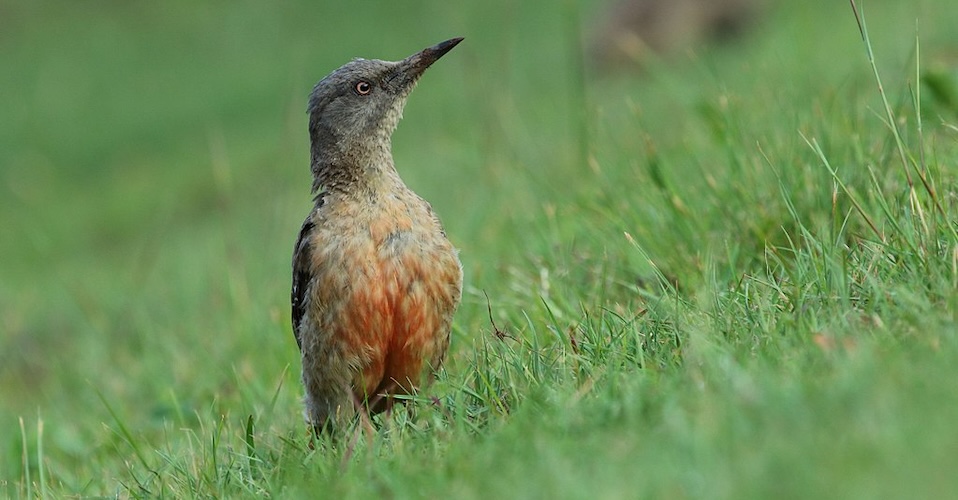
Ground Woodpecker Geocolaptes olivaceus – ©Alandmanson CC BY-SA 4.0 via Wikimedia Commons
Continental Europe, where I have conducted most of my woodpecker observations, is home to ten species, nine true woodpeckers and the migratory Northern Wryneck. Though I see and hear Black Woodpeckers almost every time I go out into the woods around Budapest I never fail to stop and admire this impressive bird.
-
Number of bird species: 236
(As at September 2025)
According to the recently (2025) amalgamated AviList, there are 236 woodpeckers, wrynecks, piculets, flickers and sapsuckers in thirty-six genera, in the Picidae family. They are:
Red-throated Wryneck Jynx ruficollis
Eurasian Wryneck Jynx torquilla
Speckled Piculet Picumnus innominatus
Bar-breasted Piculet Picumnus aurifrons
Orinoco Piculet Picumnus pumilus
Lafresny’s Piculet Picumnus lafresnayi
Golden-spangled Piculet Picumnus exilis
Ecudorian Piculet Picumnus sclateri
Scaled Piculet Picumnus squamulatus
White-bellied Piculet Picumnus spilogaster
Arrowhead Piculet Picumnus minutissimus
Spotted Piculet Picumnus pgmaeus
Speckle-chested Piculet Picumnus steindachneri
Varzea Piculet Picumnus varzeae
White-barred Piculet Picumnus cirratus
Ocellated Piculet Picumnus dorbignyanus
Ochre-collared Piculet Picumnus temminckii
White-wedged Piculet Picumnus albosquamatus
Rusty-necked Piculet Picumnus fuscus
Rufous-breasted Piculet Picumnus rufiventris
Ochraceous Piculet Picumnus limae
Mottled Piculet Picumnus nebulosus
Plain-breasted Piculet Picumnus castelnau
Fine-barred Piculet Picumnus subtilis
Olivaceous Piculet Picumnus olivaceus
Greyish Piculet Picumnus granadensis
Chestnut Piculet Picumnus cinnamomeus
African Piculet Verreauxia Africana
Rufous Piculet Sasia abnormis
White-browed Piculet Sasia achracea
Antillean Piculet Nesoctites micromegas
Heart-spotted Woodpecker Hemicircus canente
Grey-and-buff Woodpecker Hemicircus concretus
Rufous Woodpecker Micropternus brachyurus
Buff-necked Woodpecker Meiglyptes tukki
Buff-rumped Woodpecker Meiglyptes grammithorax
Zebra Woodpecker Meiglyptes tristis
Black-and-buff Woodpecker Meiglyptes jugularis
Pale-headed Woodpecker Gecinulus grantia
Bamboo Woodpecker Gecinulus viridis
Olive-backed Woodpecker Gecinulus rafflesii
Himalayan Flameback Dinopium shorii
Common Flameback Dinopium javanense
Spot-throated Flameback Dinopium everetti
Black-rumped Flameback Dinopium benghalense
Red-backed Flameback Dinopium psarodes
Crimson-winged Woodpecker Picus puniceus
Lesser Yellownape Picus chlorolophus
Scaly-bellied Woodpecker Picus squamatus
Streak-throated Woodpecker Picus xanthopygaeus
Red-collared Woodpecker Picus rabieri
Laced Woodpecker Picus vittatus
Streak-breasted Woodpecker Picus viridanus
Japanese Green Woodpecker Picus awokera
Grey-headed Woodpecker Picus canus
Black-headed Woodpecker Picus erythropygius
Levaillant’s Woodpecker Picus vaillantii
Iberian Green Woodpecker Picus sharpei
European Green Woodpecker Picus viridis
Banded Woodpecker Chrysophlegma miniaceum
Greater Yellownape Chrysophlegma flavinucha
Checker-throated Woodpecker Chrysophlegma mentale
Brown-eared Woodpecker Pardipicus caroli
Buff-spotted Woodpecker Pardipicus nivosa
Ground Woodpecker Geocolaptes olivaceus
Tullberg’s Woodpecker Campethera tullbergi
Fine-banded Woodpecker Campethera taeniolaema
Little Green Woodpecker Campethera maculosa
Nubian Woodpecker Campethera nubica
Fine-spotted Woodpecker Campethera punctuligera
Bennett’s Woodpecker Campethera bennettii
Speckle-throated Woodpecker Campethera scriptoricauda
Knysna Woodpecker Campethera notata
Golden-tailed Woodpecker Campethera abingoni
Mombassa Woodpecker Campethera mombassica
Ashy Woodpecker Mulleripicus fulvus
Northern Sooty Woodpecker Mulleripicus funebris
Southern Sooty Woodpecker Mulleripicus fuliginosus
Great Slaty Woodpecker Mulleripicus pulverulentus
Pileated Woodpecker Dryocopus pileatus
Black-bodied Woodpecker Dryocopus schulzii
Lineated Woodpecker Dryocopus lineatus
Black Woodpecker Dryocopus martius
Andaman Woodpecker Dryocopus hodgei
White-bellied Woodpecker Dryocopus javensis
Cinnamon Woodpecker Celeus loricatus
Ringed Woodpecker Celeus torquatus
Helmeted Woodpecker Celeus galeatus
Chestnut-colored Woodpecker Celeus castaneus
Waved Woodpecker Celeus undatus
Cream-colored Woodpecker Celeus flavus
Rufous-headed Woodpecker Celeus spectabilis
Kaempfer’s Woodpecker Celeus obrieni
Ochre-backed Woodpecker Celeus ochraceus
Chestnut Woodpecker Celeus elegans
Pale-crested Woodpecker Celeus lugubris
Blond-crested Woodpecker Celeus flavescens
Rufous-winged Woodpecker Piculus simplex
Stripe-cheeked Woodpecker Piculus callopterus
White-throated Woodpecker Piculus leucolaemus
Lita Woodpecker Piculus litae
Yellow-throated Woodpecker Piculus flavigula
Golden-green Woodpecker Piculus chrysochloros
Yellow-browed Woodpecker Piculus aurulentus
Golden-olive Woodpecker Colaptes rubiginosus
Grey-crowned Woodpecker Colaptes auricularis
Crimson-mantled Woodpecker Colaptes rivolii
Black-necked Woodpecker Colaptes atricollis
Spot-breasted Woodpecker Colaptes punctigula
Green-barred Woodpecker Colaptes melanochloros
Northern Flicker Colaptes auratus
Guatemalan Flicker Colaptes mexicanoides
Gilded Flicker Colaptes chrysoides
Fernandina’s Flicker Colaptes fernandinae
Chilean Flicker Colaptes pitius
Andean Flicker Colaptes rupicola
Campo Flicker Colaptes campestris
Powerful Woodpecker Campephilus pollens
Crimson-bellied Woodpecker Campephilus haematogaster
Splendid Woodpecker Campephilus speldens
Red-necked Woodpecker Campephilus rubricollis
Robust Woodpecker Campephilus robustus
Crimson-crested Woodpecker Campephilus melanoleucos
Pale-billed Woodpecker Campephilus guatemalensis
Guayaquil Woodpecker Campephilus gayaquilensis
Cream-backed Woodpecker Campephilus leucopogon
Magellanic Woodpecker Campephilus magellanicus
Ivory-billed Woodpecker Campephilus principalis
Imperial Woodpecker Campephilus imperialis
Maroon Woodpecker Blythipicus rubiginosus
Bay Woodpecker Blythipicus pyrrhotis
Orange-backed Flameback Chrysocolaptes
Greater Flameback Chrysocolaptes guttacristatus
Malabar Flameback Chrysocolaptes socialis
Javan Flameback Chrysocolaptes strictus
Luzon Flameback Chrysocolaptes haematribon
Yellow-faced Flameback Chrysocolaptes xanthocephalus
Buff-spotted Flameback Chrysocolaptes lucidus
Red-headed Flameback Chrysocolaptes erythrocephalus
Crimson-backed Flameback Chrysocolaptes stricklandi
White-naped Woodpecker Chrysocolaptes festivus
Williamson’s Sapsucker Sphyrapicus thyroideus
Yellow-bellied Sapsucker Sphyrapicus varius
Red-naped Sapsucker Sphyrapicus nuchalis
Red-breasted Sapsucker Sphyrapicus ruber
Cuban Green Woodpecker Xiphidiopicus percussus
White Woodpecker Melanerpes candidus
Lewis’s Woodpecker Melanerpes lewis
Guadeloupe Woodpecker Melanerpes herminieri
Puerto Rican Woodpecker Melanerpes portoricensis
Red-headed Woodpecker Melanerpes erythrocephalus
Acorn Woodpecker Melanerpes formicivorus
Golden-naped Woodpecker Melanerpes chrysauchen
Yellow-tufted Woodpecker Melanerpes cruentatus
Yellow-fronted Woodpecker Melanerpes flavifrons
Beautiful Woodpecker Melanerpes pulcher
Black-cheeked Woodpecker Melanerpes pucherani
White-fronted Woodpecker Melanerpes cactorum
Hispaniolan Woodpecker Melanerpes striatus
Jamaican Woodpecker Melanerpes radiolatus
Golden-cheeked Woodpecker Melanerpes chrysogenys
Grey-breasted Woodpecker Melanerpes hypolius
Yucatan Woodpecker Melanerpes pygmaeus
Red-crowned Woodpecker Melanerpes rubricapillus
Gila Woodpecker Melanerpes uropygialis
Hoffmann’s Woodpecker Melanerpes hoffmannii
Golden-fronted Woodpecker Melanerpes aurifrons
Red-bellied Woodpecker Melanerpes carolinus
West Indian Woodpecker Melanerpes supercilliaris
Black-backed Woodpecker Picoides arcticus
American Three-toed Woodpecker Picoides dorsalis
Eurasian Three-toed Woodpecker Picoides tridactylus
Sulawesi Pygmy Woodpecker Yungipicus temminckii
Philippine Pygmy Woodpecker Yungipicus maculatus
Sulu Pygmy Woodpecker Yungipicus ramsayi
Brown-capped Pygmy Woodpecker Yungipicus nanus
Sunda Pygmy Woodpecker Yungipicus moluccensis
Grey-capped Pygmy Woodpecker Yungipicus canicapillus
Japanese Pygmy Woodpecker Yungipicus kizuki
Yellow-crowned Woodpecker Leiopicus mahrattensis
Middle Spotted Woodpecker Dendrocoptes medius
Brown-fronted Woodpecker Dendrocoptes auriceps
Arabian Woodpecker Dendrocoptes dorae
Fire-bellied Woodpecker Chloropicus pyrrhogaster
Yellow-crested Woodpecker Chloropicus xantholophus
Bearded Woodpecker Chloropicus namaquus
Stierling’s Woodpecker Dendropicos stierlingi
Brown-backed Woodpecker Dendropicos obsoletus
African Grey Woodpecker Dendropicos goertae
Eastern Grey Woodpecker Dendropicos spodocephalus
Olive Woodpecker Dendropicos griseocephalus
Abyssinian Woodpecker Dendropicos abyssinicus
Melancholy Woodpecker Dendropicos lugubris
Gabon Woodpecker Dendropicos gabonensis
Elliot’s Woodpecker Dendropicos elliotii
Little Grey Woodpecker Dendropicos elachus
Speckle-breasted Woodpecker Dendropicos poecilolaemus
Cardinal Woodpecker Dendropicos fuscescens
Rufous-bellied Woodpecker Dendrocopos hyperythrus
Stripe-breasted Woodpecker Dendrocopos atratus
Fulvous-breasted Woodpecker Dendrocopos mace
Freckle-breasted Woodpecker Dendrocopos analis
Okinawa Woodpecker Dendrocopos noguchii
White-backed Woodpecker Dendrocopos leucotos
Darjeeling Woodpecker Dendrocopos darjellensis
White-winged Woodpecker Dendrocopos leucopterus
Great Spotted Woodpecker Dendrocopos major
Himalayan Woodpecker Dendrocopos himalayensis
Sind Woodpecker Dendrocopos assimilis
Syrian Woodpecker Dendrocopos syriacus
Lesser Spotted Woodpecker Dryobates minor
Crimson-breasted Woodpecker Dryobates cathpharius
Necklaced Woodpecker Dryobates pernyii
Downy Woodpecker Dryobates pubescens
Nuttall’s Woodpecker Dryobates nuttallii
Ladder-backed Woodpecker Dryobates scalaris
Red-cockaded Woodpecker Leuconotopicus borealis
Hairy Woodpecker Leuconotopicus villosus
White-headed Woodpecker Leuconotopicus albolarvatus
Smoky-brown Woodpecker Leuconotopicus fumigatus
Strickland’s Woodpecker Leuconotopicus stricklandi
Arizona Woodpecker Leuconotopicus arizonae
Red-rumped Woodpecker Veniliornis kirkii
Golden-collared Woodpecker Veniliornis cassini
White-spotted Woodpecker Veniliornis spilogaster
Checkered Woodpecker Veniliornis mixtus
Striped Woodpecker Veniliornis lignarius
Blood-colored Woodpecker Veniliornis sanguineus
Little Woodpecker Veniliornis passerinus
Dot-fronted Woodpecker Veniliornis frontalis
Scarlet-backed Woodpecker Veniliornis callonotus
Yellow-vented Woodpecker Veniliornis dignus
Bar-bellied Woodpecker Veniliornis nigriceps
Red-stained Woodpecker Veniliornis affinis
Choco Woodpecker Veniliornis chocoensis
Yellow-eared Woodpecker Veniliornis maculifrons
-
In Search of the Ivory-Billed Woodpecker
| By Jerome A Jackson | Harper Collins | 2006 | Paperback | 294 pages, colour plates | ISBN: 9780060891558 Buy this book from NHBS.com -
Ivorybill Hunters – The Search for Proof in a Flooded Wilderness
| By Geoffrey E Hill | OUP | 2007 | Hardback | 260 pages, 59 halftones, 11 line illustrations | ISBN: 9780195323467 Buy this book from NHBS.com -
The Black Woodpecker: A Monograph on Dryocopus Martius
| By Gerard Gorman | Lynx Edicions | 2011 | Hardback | 184 pages, 16 colour plates, colour & b/w photos & illustrations, colour maps | ISBN: 9788496553798 Buy this book from NHBS.com -
The Red-Cockaded Woodpecker
| (Surviving in a Fire Maintained Ecosystem) | by Richard N Connor, D Craig Rudolph & Jeffery R Walters | University of Texas Press | 2001 | Hardback | 363 pages, colour photos, b/w photos, illustrations, figures, tables | ISBN: 9780292712348 Buy this book from NHBS.com -
Woodpeckers
| (A Guide to the Woodpeckers, Piculets and Wrynecks of the World) | By Hans Winkler, David A Christie & David Nurney | Pica Press | 1995 | Hardback | 406 pages, 64 colour plates, line illustrations, maps | ISBN: 9781873403259 Buy this book from NHBS.com -
Woodpeckers of Europe - A study of the European Picidae
| By Gerard Gorman | Bruce Coleman Books | 2004 | Hardback | 192 pages, Colour plates, distribution maps, 72 line illustrations | ISBN: 9781872842059 Buy this book from NHBS.com
-
Picidae
Family AccountWoodpeckers live in a wide variety of habitats, from high mountains to low deserts and from open grasslands and savannas to dense, old-growth forests. -
Picidae
Family AccountThe Picidae are one of nine living families in the order Piciformes, the others being barbets (comprising three families), toucans, toucan-barbets... -
Picidae
Family AccountDespite their distinctive habit of climbing up trees, not all feed in trees. Distributed around the world they range in size from the tiny piculets (only 8cm long) to the massive Imperial Woodpecker (55cm), both from South America; British species are somewhat intermediate!
Given the number of species in this family, Fatbirder does not provide quick links to all of them. However, the entries below do include links to representatives of every genera, all those illustrated and some of the most often encountered, iconic or sought-after species.
-
Acorn Woodpecker Melanerpes formicivorus
Species AccountThe acorn woodpecker (Melanerpes formicivorus) is a medium-sized woodpecker, 21 cm (8.3 in) long, with an average weight of 85 g (3.0 oz). -
Acorn Woodpecker Melanerpes formicivorus
Species AccountSound archive and distribution map. -
African Piculet Verreauxia Africana
Species AccountA tiny woodpecker of forest and forest edge, more likely to be mistaken for a crombec than for another species of woodpecker. -
African Piculet Verreauxia Africana
Species AccountSound archive and distribution map. -
American Three-toed Woodpecker Picoides dorsalis
Species AccountInconspicuous and uncommon woodpecker of coniferous forests, particularly spruces, often at high elevations (especially in the Rockies). -
American Three-toed Woodpecker Picoides dorsalis
Species AccountSound archive and distribution map. -
Andean Flicker Colaptes rupicola
Species AccountMainly feeds on the ground. Nests in cavities in dirt bluffs, walls of old buildings, sometimes in colonies. -
Andean Flicker Colaptes rupicola
Species AccountSound archive and distribution map. -
Antillean Piculet Nesoctites micromegas
Species AccountThe Antillean piculet (Nesoctites micromegas) is a species of bird in subfamily Picinae of the woodpecker family Picidae. It is endemic to the Caribbean island -
Antillean Piculet Nesoctites micromegas
Species AccountSound archive and distribution map. -
Bearded Woodpecker Chloropicus namaquus
Species AccountThe bearded woodpecker (Chloropicus namaquus) is a species of bird in the family Picidae. It has a distinctive black and white head and brownish barred body. -
Bearded Woodpecker Chloropicus namaquus
Species AccountSound archive and distribution map. -
Bennett’s Woodpecker Campethera bennettii
Species AccountA medium-sized woodpecker with spotted rather than streaked or barred underparts. -
Bennett’s Woodpecker Campethera bennettii
Species AccountSound archive and distribution map. -
Black-rumped Flameback Dinopium benghalense
Species AccountA common, “small-billed” golden-backed woodpecker with four toes. Endemic to the Indian subcontinent and Sri Lanka. -
Black-rumped Flameback Dinopium benghalense
Species AccountSound archive and distribution map. -
Buff-rumped Woodpecker Meiglyptes grammithorax
Species AccountAdorable small woodpecker with a large crested head, boldly marked black-and-white wings, and big dark eyes. Also note finely barred belly. -
Buff-rumped Woodpecker Meiglyptes grammithorax
Species AccountSound archive and distribution map. -
Buff-spotted Woodpecker Pardipicus nivosa
Species AccountThe buff-spotted woodpecker (Pardipicus nivosus) is a species of bird in the family Picidae. It is native to large parts of tropical central Africa. -
Buff-spotted Woodpecker Pardipicus nivosa
Species AccountSound archive and distribution map. -
Checker-throated Woodpecker Chrysophlegma mentale
Species AccountSound archive and distribution map. -
Checker-throated Woodpecker Chrysophlegma mentale
Species AccountOrnate medium-sized woodpecker. Moss-green with blood-red wings and neck. Back edge of head and neck are brightened by a sunny yellow crest. -
Checkered Woodpecker Veniliornis mixtus
Species AccountThe checkered woodpecker (Veniliornis mixtus) is a species of bird in subfamily Picinae of the woodpecker family Picidae. -
Checkered Woodpecker Veniliornis mixtus
Species AccountSound archive and distribution map. -
Cinnamon Woodpecker Celeus loricatus
Species AccountEl carpintero canelo (Celeus loricatus) es una especie de ave de a familia Picidae, que se encuentra en Colombia, Costa Rica, Ecuador, Nicaragua y Panamá. -
Cinnamon Woodpecker Celeus loricatus
Species AccountSound archive and distribution map. -
Crimson-bellied Woodpecker Campephilus haematogaster
Species AccountThe crimson-bellied woodpecker (Campephilus haematogaster) is a species of bird in the subfamily Picinae of the woodpecker family Picidae. -
Crimson-bellied Woodpecker Campephilus haematogaster
Species AccountSound archive and distribution map. -
Cuban Green Woodpecker Xiphidiopicus percussus
Species AccountThe Cuban green woodpecker (Xiphidiopicus percussus) is a species of woodpecker in the family Picidae and tribe Melanerpini, known locally in Cuban Spanish -
Cuban Green Woodpecker Xiphidiopicus percussus
Species AccountSound archive and distribution map. -
Downy Woodpecker Dryobates pubescens
Species AccountTiny woodpecker, common and widespread across much of North America. Black-and-white plumage is nearly identical to the larger Hairy Woodpecker. -
Downy Woodpecker Dryobates pubescens
Species AccountSound archive and distribution map. -
Elliot's Woodpecker Dendropicos elliotii
Species AccountElliot's woodpecker (Dendropicos elliotii) is a species of bird in the family Picidae. It has an extremely wide range and is described as an uncommon species. -
Elliot's Woodpecker Dendropicos elliotii
Species AccountSound archive and distribution map. -
Eurasian Wryneck Jynx torquilla
Species AccountThe Eurasian wryneck (Jynx torquilla) is a species of wryneck in the woodpecker family. This species mainly breeds in temperate regions of Europe and Asia. Most populations are migratory, wintering in tropical Africa and in southern Asia from Iran to the Indian Subcontinent, but some are resident in northwestern Africa. It is a bird of open countryside, woodland and orchards. -
Eurasian Wryneck Jynx torquilla
Species AccountSound archive and distribution map. -
European Green Woodpecker Picus viridis
Species AccountFairly large, mostly green woodpecker, unmistakable throughout much of range. Note red crown, pale eyes, and black face (male has red whisker mark). -
European Green Woodpecker Picus viridis
Species AccountSound archive and distribution map. -
Great-spotted Woodpecker Dendrocopos major
Species AccountThe great spotted woodpecker (Dendrocopos major) is found across Eurasia and parts of North Africa. this woodpecker is mainly resident unless the conifer cone crop in the north of its range collapses, but the tendency of some birds to wander widely means that it has recolonised Ireland and is a rare visitor to North America. -
Great-spotted Woodpecker Dendrocopos major
Species AccountAbout blackbird-sized and striking black-and-white. It has a very distinctive bouncing flight and spends most of its time clinging to tree trunks and branches, often trying to hide on the side away from the observer. -
Great-spotted Woodpecker Dendrocopos major
Species AccountSound archive and distribution map. -
Greater Flameback Chrysocolaptes guttacristatus
Species AccountA large, crested woodpecker with a golden back found in wet tropical and subtropical forests across South and Southeast Asia. -
Greater Flameback Chrysocolaptes guttacristatus
Species AccountSound archive and distribution map. -
Grey-and-buff Woodpecker Hemicircus concretus
Species AccountSound archive and distribution map. -
Grey-and-buff Woodpecker Hemicircus concretus
Species AccountSmall stout woodpecker with an oversized crested head and black-and-white scaling on the back. Males have a brilliant red front to the crest that females lack. -
Ground Woodpecker Geocolaptes olivaceus
Species AccountThe ground woodpecker (Geocolaptes olivaceus) is one of only three ground-dwelling woodpeckers in the world (the others are the Andean and campo flickers). -
Ground Woodpecker Geocolaptes olivaceus
Species AccountSound archive and distribution map. -
Hairy Woodpecker Picoides villosus
Species AccountThe hairy woodpecker (Picoides villosus) is a medium-sized woodpecker, averaging approximately 250 mm (9.8 in) in length with a 380 mm (15 in) wingspan. -
Hairy Woodpecker Picoides villosus
Species AccountSound archive and distribution map. -
Lewis’s Woodpecker Melanerpes lewis
Species AccountLewis's woodpecker (Melanerpes lewis) is a large North American species of woodpecker which ornithologist Alexander Wilson named after Meriwether Lewis. -
Lewis’s Woodpecker Melanerpes lewis
Species AccountSound archive and distribution map. -
Maroon Woodpecker Blythipicus rubiginosus
Species AccountDark reddish woodpecker with a gleaming yellow bill and gray-brown head and underparts. Female averages paler-headed than the male. -
Maroon Woodpecker Blythipicus rubiginosus
Species AccountSound archive and distribution map. -
Middle Spotted Woodpecker Dendrocoptes medius
Species AccountSound archive and distribution map. -
Middle Spotted Woodpecker Dendrocoptes medius
Species AccountMedium-large black-and-white woodpecker. Marginally smaller than Great Spotted Woodpecker, but rounded head and shortish beak exaggerate this size difference. -
Northern Flicker Colaptes auratus
Species AccountThe northern flicker or common flicker (Colaptes auratus) is a medium-sized bird of the woodpecker family. It is native to most of North America. -
Northern Flicker Colaptes auratus
Species AccountSound archive and distribution map. -
Olive-backed Woodpecker Gecinulus rafflesii
Species AccountThe olive-backed woodpecker (Gecinulus rafflesii) is a species of bird in the woodpecker family Picidae that is found in Southeast Asia. -
Olive-backed Woodpecker Gecinulus rafflesii
Species AccountSound archive and distribution map. -
Pale-crested Woodpecker Celeus lugubris
Species AccountDistinctive woodpecker with a prominent pointed crest. Has a dark cinnamon-brown back scaled with yellow and a yellow rump. -
Pale-crested Woodpecker Celeus lugubris
Species AccountSound archive and distribution map. -
Philippine Pygmy Woodpecker Yungipicus maculatus
Species AccountThe Philippine pygmy woodpecker (Yungipicus maculatus), also known as the Philippine woodpecker, is a species of bird in the woodpecker family (Picidae). -
Philippine Pygmy Woodpecker Yungipicus maculatus
Species AccountSound archive and distribution map. -
Pileated Woodpecker Dryocopus pileatus
Species AccountLarge, unmistakable woodpecker. Mostly black, with red crest and bold white stripes on head and neck. Flies with deep, rowing wingbeats. -
Pileated Woodpecker Dryocopus pileatus
Species AccountSound archive and distribution map. -
Red-cockaded Woodpecker Picoides borealis
Species AccountSound archive and distribution map. -
Red-cockaded Woodpecker Picoides borealis
Species AccountThe red-cockaded woodpecker (Leuconotopicus borealis) is a woodpecker found in southeastern North America. -
Red-headed Woodpecker Melanerpes erythrocephalus
Species AccountThe red-headed woodpecker (Melanerpes erythrocephalus) is a small or medium-sized woodpecker from temperate North America. Their breeding habitat is open country across southern Canada and the eastern-central United States. The species is listed as Near Threatened by the IUCN. -
Red-headed Woodpecker Melanerpes erythrocephalus
Species AccountSound archive and distribution map. -
Rufous Piculet Sasia abnormis
Species AccountAbsolutely miniscule woodpecker. Tailless and round-bodied, resembling a wren or cupwing in shape. Olive above and orange below; lacks the white brow patch. -
Rufous Piculet Sasia abnormis
Species AccountSound archive and distribution map. -
Rufous Woodpecker Micropternus brachyurus
Species AccountOdd medium-sized brownish woodpecker with a short dark bill. Overall coloration and wing markings vary considerably across a wide range. -
Rufous Woodpecker Micropternus brachyurus
Species AccountSound archive and distribution map. -
Rufous-winged Woodpecker Piculus simplex
Species AccountThe rufous-winged woodpecker (Piculus simplex) is a species of bird in subfamily Picinae of the woodpecker family Picidae. It is found in Costa Rica... -
Rufous-winged Woodpecker Piculus simplex
Species AccountSound archive and distribution map. -
Southern Sooty Woodpecker Mulleripicus fuliginosus
Species AccountA large woodpecker of lowland forest in the southern Philippines. Overall sooty-gray with a fairly long pointed tail, fine speckling on the head, pale eyes... -
Southern Sooty Woodpecker Mulleripicus fuliginosus
Species AccountSound archive and distribution map. -
Syrian Woodpecker Dendrocopos syriacus
Species AccountThe Syrian woodpecker (Dendrocopos syriacus) is a member of the woodpecker family, the Picidae. -
Syrian Woodpecker Dendrocopos syriacus
Species AccountSound archive and distribution map. -
White-barred Piculet Picumnus cirratus
Species AccountTiny woodpecker of woodlands, forest edges, second growth, and riparian forests. -
White-barred Piculet Picumnus cirratus
Species AccountSound archive and distribution map. -
White-bellied Piculet Picumnus spilogaster
Species AccountLearn about White-bellied Piculet (White-bellied): explore photos, sounds, and observations collected by birders around the world. -
White-bellied Piculet Picumnus spilogaster
Species AccountSound archive and distribution map. -
Yellow-bellied Sapsucker Sphyrapicus varius
Species AccountThe yellow-bellied sapsucker (Sphyrapicus varius) is a medium-sized woodpecker that breeds in Canada and the northeastern United States. -
Yellow-bellied Sapsucker Sphyrapicus varius
Species AccountSound archive and distribution map. -
Yellow-crowned Woodpecker Leiopicus mahrattensis
Species AccountThe yellow-crowned woodpecker (Leiopicus mahrattensis) or Mahratta woodpecker is a species of small pied woodpecker found in the Indian subcontinent. -
Yellow-crowned Woodpecker Leiopicus mahrattensis
Species AccountSound archive and distribution map. -
Yellow-fronted Woodpecker Melanerpes flavifrons
Species AccountMulticolored, gregarious medium-sized woodpecker. Note black wings, tail, and mask, yellow forehead and eyering, white rump, and red belly bordered with... -
Yellow-fronted Woodpecker Melanerpes flavifrons
Species AccountSound archive and distribution map.
-
Gerard Gorman
Budapest, Hungary | gerard@probirder.com
http://www.probirder.com
-
Woodpeckers of Europe
BlogWoodpeckers of Europe is dedicated to the 10 species of woodpecker (Picidae) that breed in Europe: 9 resident species and the migratory Wryneck. 8 of these 10 also occur outside Europe, with the distribution of Eurasian Three-toed, White-backed, Lesser Spotted, Great Spotted, Black & Grey-headed Woodpeckers stretching eastwards from the Western Palearctic into Asia, whilst Syrian is found in the Middle East & Asia Minor & Wryneck winters in Africa. The global ranges of Green & Middle Spotted Woodpeckers are confined to the Western Palearctic. -
Woodpeckers of the World
BlogPhotographs, sounds, habitats, data & discussion on the world's Picidae…


